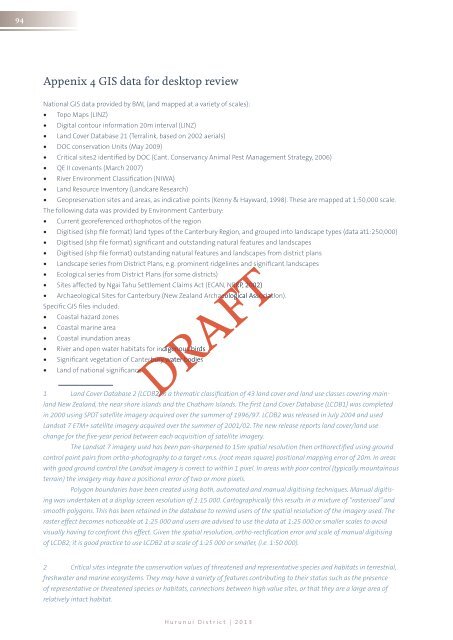Important Natural Landscapes (Boffa Miskell, 2013)
Important Natural Landscapes (Boffa Miskell, 2013)
Important Natural Landscapes (Boffa Miskell, 2013)
- No tags were found...
You also want an ePaper? Increase the reach of your titles
YUMPU automatically turns print PDFs into web optimized ePapers that Google loves.
94Appenix 4 GIS data for desktop reviewNational GIS data provided by BML (and mapped at a variety of scales): Topo Maps (LINZ) Digital contour information 20m interval (LINZ) Land Cover Database 21 (Terralink, based on 2002 aerials) DOC conservation Units (May 2009) Critical sites2 identified by DOC (Cant. Conservancy Animal Pest Management Strategy, 2006) QE II covenants (March 2007) River Environment Classification (NIWA) Land Resource Inventory (Landcare Research)Geopreservation sites and areas, as indicative points (Kenny & Hayward, 1998). These are mapped at 1:50,000 scale.The following data was provided by Environment Canterbury: Current georeferenced orthophotos of the region Digitised (shp file format) land types of the Canterbury Region, and grouped into landscape types (data at1:250,000) Digitised (shp file format) significant and outstanding natural features and landscapes Digitised (shp file format) outstanding natural features and landscapes from district plans Landscape series from District Plans, e.g. prominent ridgelines and significant landscapesEcological series from District Plans (for some districts) Sites affected by Ngai Tahu Settlement Claims Act (ECAN, NRRP, 2002) Archaeological Sites for Canterbury (New Zealand Archaeological Association).Specific GIS files included: Coastal hazard zones Coastal marine area Coastal inundation areas River and open water habitats for indigenous birds Significant vegetation of Canterbury water bodiesLand of national significanceDRAFTFT1 Land Cover Database 2 (LCDB2) is a thematic classification of 43 land cover and land use classes covering mainlandNew Zealand, the near shore islands and the Chatham Islands. The first Land Cover Database (LCDB1) was completedin 2000 using SPOT satellite imagery acquired over the summer of 1996/97. LCDB2 was released in July 2004 and usedLandsat 7 ETM+ satellite imagery acquired over the summer of 2001/02. The new release reports land cover/land usechange for the five-year period between each acquisition of satellite imagery.The Landsat 7 imagery used has been pan-sharpened to 15m spatial resolution then orthorectified using groundcontrol point pairs from ortho-photography to a target r.m.s. (root mean square) positional mapping error of 20m. In areaswith good ground control the Landsat imagery is correct to within 1 pixel. In areas with poor control (typically mountainousterrain) the imagery may have a positional error of two or more pixels.Polygon boundaries have been created using both, automated and manual digitising techniques. Manual digitisingwas undertaken at a display screen resolution of 1:15 000. Cartographically this results in a mixture of “rasterised” andsmooth polygons. This has been retained in the database to remind users of the spatial resolution of the imagery used. Theraster effect becomes noticeable at 1:25 000 and users are advised to use the data at 1:25 000 or smaller scales to avoidvisually having to confront this effect. Given the spatial resolution, ortho-rectification error and scale of manual digitisingof LCDB2, it is good practice to use LCDB2 at a scale of 1:25 000 or smaller, (i.e. 1:50 000).2 Critical sites integrate the conservation values of threatened and representative species and habitats in terrestrial,freshwater and marine ecosystems. They may have a variety of features contributing to their status such as the presenceof representative or threatened species or habitats, connections between high value sites, or that they are a large area ofrelatively intact habitat.Hurunui District | <strong>2013</strong>
















